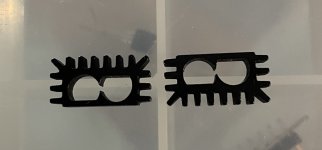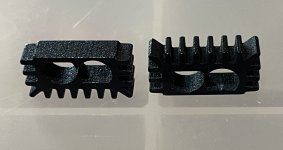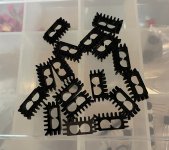I have the JFET heatsinks made by Patrick(EUVL) and his associate. Please see attached pixs. I have 16 PCs and they are all the same type.
Asking $14/pc OBO.
Asking $14/pc OBO.
Attachments
For heat sinking or thermal couplingWhen/in which situation do you need those?
I think it would have been more informative if you'd named the cases instead of the transistor technology 😉 .
Best regards!
Best regards!
I see the point for thermal coupling, but why would TO-92 transistors need cooling? Their die is encased in plastics, without thermal coupling to a metal piece that that could be attached to a heatsink, so heat sinks will have a poor performance.For heat sinking or thermal coupling
I think these were originally produced to serve the purpose of thermo coupling and not really cooling.
Maybe if you were trying to run the Toshibas towards the top of their current range it would help with cooling?
I got some with a CEN/SEN IV stage kit I bought in the swap meet unused.
It may have been relevant in that application to have the Toshiba j74/k170 thermo coupled for optimal performance/balance.
I’ve also seen people thermo couple the Toshiba transistors in the F5. I don’t think these would work there as they are usually tied together back to back.
eBay seller punkydawg sells the Toshiba j74/k170 as well as round thermo coupling hats that work on them back to back.
Maybe if you were trying to run the Toshibas towards the top of their current range it would help with cooling?
I got some with a CEN/SEN IV stage kit I bought in the swap meet unused.
It may have been relevant in that application to have the Toshiba j74/k170 thermo coupled for optimal performance/balance.
I’ve also seen people thermo couple the Toshiba transistors in the F5. I don’t think these would work there as they are usually tied together back to back.
eBay seller punkydawg sells the Toshiba j74/k170 as well as round thermo coupling hats that work on them back to back.
Last edited:
While this is called "Heatsink", the main purpose of its usage is for thermal coupling. Heat-sinking is just a sidekick. It allows the assembly to be used as replacement for dual JFETs: K389/J109 with single K170/J74. You should use epoxy to glue the JFETs to the heasink. The HS were CNC-wire-cuted from solid alu with black anodized finishing.I see the point for thermal coupling, but why would TO-92 transistors need cooling? Their die is encased in plastics, without thermal coupling to a metal piece that that could be attached to a heatsink, so heat sinks will have a poor performance.
They cost 30 HKD a piece ( ~ 4 USD) in a previous GB in 2018.
https://www.diyaudio.com/community/threads/toshiba-dual-jfet-heatsink.135359/post-5365940
What they are meant for, is explained here .
https://www.diyaudio.com/community/threads/the-next-best-thing-to-2sk389-2sj109.135154/
Patrick
https://www.diyaudio.com/community/threads/toshiba-dual-jfet-heatsink.135359/post-5365940
What they are meant for, is explained here .
https://www.diyaudio.com/community/threads/the-next-best-thing-to-2sk389-2sj109.135154/
Patrick
Last edited:
The thermal inertia concept with epoxy resin cases and big heatsink in thermally unregulated space is false.You need to raise the case temperature to have thermal inertia and what that heatsink does is lowering it further in an unregulated ambient with poor thermal coupling thus offering no real thermal tracking of each other case.That is why japanese double jfets were only encased in a thin aluminium sheet.Either you sacrifice some of the noise specs in order to get thermal inertia or you artificially cool down the space in which the thermal coupling is done to create a thermal potential that brings both cases to the same temperature.



 ...
...